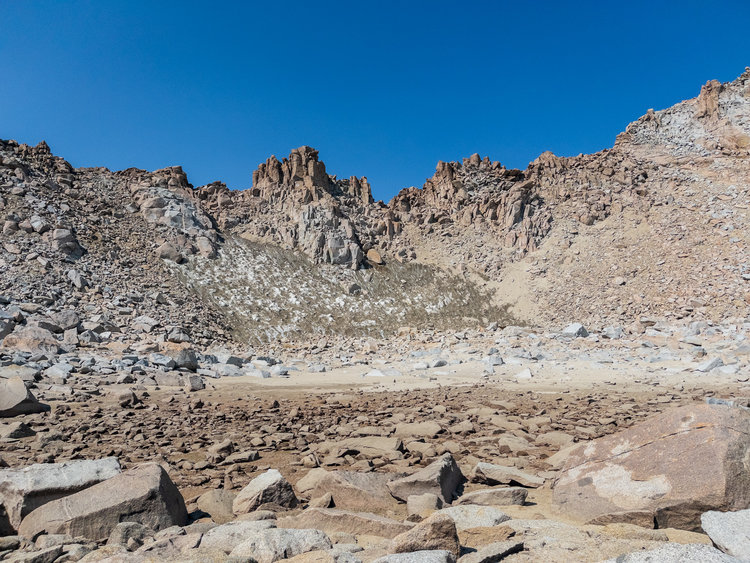Lumbergh21
I was thinking of the terminus of Lamarck Col as Lake 4, not down Darwin Benches or the JMPCT. I agree that the talus alongside the middle lakes is the worst part if you include them! I've never had any issues with the snow on the eastside of the col in the half dozen or more time I've been over it (it's either been bootpacked or I've been able to easily kick in steps) but I agree that if it is icy it'd be an issue. There was hardly any snow on the col last July (the pond below it was completely dry), so that might be something of the past.

There are some routes that regularly hold snow year round (vs in a heavy winter in June this will have snow)... I'm not sure that'd be worth breaking out a qualifier for.

- 2021-08-12
I agree the ambigous Valor photo is technically class 3 in the current system, but it was one of those other things piling up in the back of my head - why am I describing something as "actual class 3" and then something else as "technically class 3 that might not be experienced as class 3".
I sympathize with things being different with a pack and without, and there's definitely time when I deliberately step slowly on talus (force = mass x acceleration) but I'm not sure how to qualify that. I think if something is stable without a pack and loose with one, the loose takes precedence, but that's probably the only area where it's impacted. Class 3 is still Class 3 even if it's harder with a pack - or one would choose not to go up it!
Wandering Daisy
It's definitely valuable getting different perspectives - I guess I just routefind around tight spots in Talus. I can imagine them quite easily but don't remember really hitting them in the Sierra, vs maybe doing so every 2-3 dayhikes in the southwest with a ~10L shoulder sling pack with smartwater bottles on the outside of it. Sometimes I can hop from little grassy spot to little grassy spot in talus fields, or I'll kick myself later when seeing a far better route than the one I took (the east side of north glacier pass comes to mind). There are some spots where realistically you're moving over large gaps in talus and that should be differentiated.
Aiming for an average experienced backpacker is what I'm trying for, and why aimed this system for HST vs global aspirations (though a more inclusive YDS would be a good thing). I can fully understand why a guidebook for the general public you chose the movie system rating - there's no interaction between readers or easy alternate context handy like on this forum.
I think some sort of explicit "standard conditions" disclaimer is warranted. One of my partner's friend's had their fiancé die a few years back in Colorado due to a loose boulder in snow soaked ground that rolled over them. I don't think that's something that can be broken down into every single situation, but perhaps a sentence in Class 2 or Loose regarding terrain heavily saturated by recent storms, early season snow melt, or in recent burn scars. I see the class ratings and overview as an educational opportunity, but if one tries to mention every hazard possible it'll just be a wall of text.
I will admit that I have a few pants that only fit either pre or post backpacking season... ^^ When I was in my early 30s I'd drop from 32" to 30" from June to Septmber, now it's more like 33-34" to 32-33".
 frozenintime
frozenintime
Yeah, the +- was me trying to find that spot between 2 and 3 which stymies backpackers - just calling it 2.5 and being explicit about it vs "well it's 2 for some but 3 for others, be aware of this fact every time you're on something that feels marginally at the upper or lower bounds" feels a lot better. It helped clarify some things for myself as well.
I agree consequentially loose is a mouthful, but I think "loose" and "sliding" are about as important as exposure. An exposed class 2 slab above a cliff out is different from ball bearings above a cliff out, even if they're the same exposure - I'm not sure I want to have separate exposure ratings for stable ground above exposure and loose ground above exposure,
Terrain that collapses on itself can be as dangerous as exposure, and for some people less preferable. Huh, I might have "collapsing" as my replacement term for "sliding" which in turn replaced "consequentially loose".

I agree that if someone just came across the system without knowing anything about it, it wouldn't be naturally intuitive like PG/R/X - but then again L/S/X or L/C/X isn't -that- much to remember.
General thoughts
Should there be two exposure ratings? I honestly don't really know where a fall would be fatal or just result in serious injuries (or people that would be cool being busted up enough for a heli out but balk at death on impact), and I feel like "exposure which won't result in a serious injury or death" would be hard to quantify or judge. In introducing 2.5 I used the example of someone feeling exposed on a 3-4 foot Class 2.5 drop/scooch. Maybe just bake this into the Class system? I'll take a stab at this below.
I'm liking Collapsing and then using "sliding" instead of what I had as "loose" before - it feels a bit more impactful?
We could also just "unpack" the shorthand and just say "loose/sliding, collapsing, fatally exposed, exposed, holds snow" etc.
